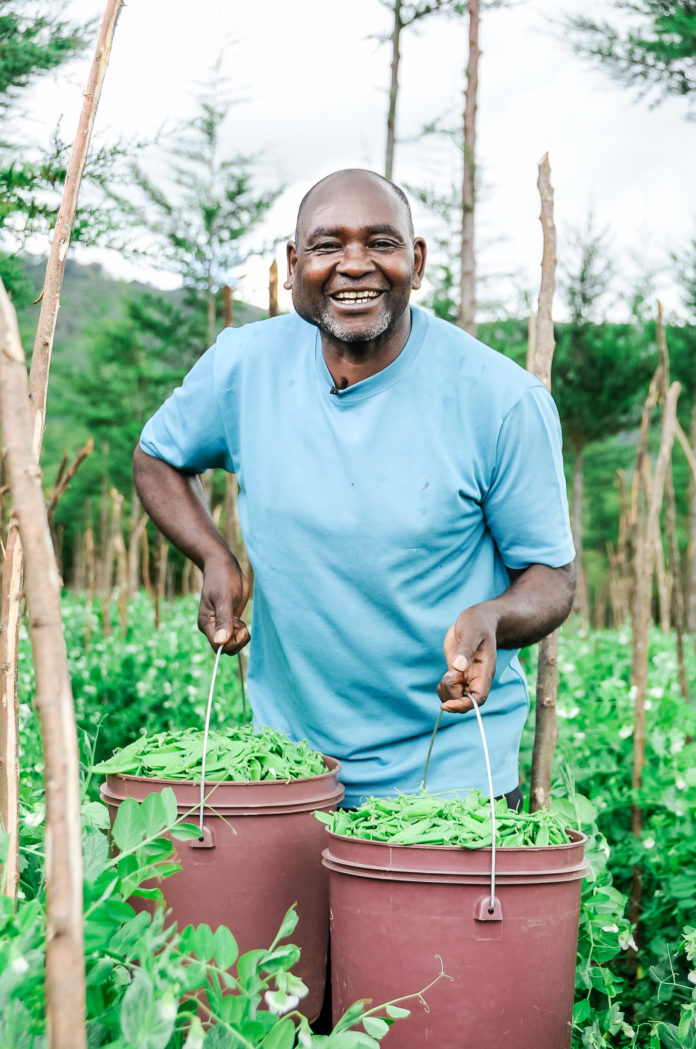By Leopold Obi
Jamleck Macharia, 51, is a snow peas farmer in the Aberdare Forest , 250 Kilometres North-West of Kenya’s capital Nairobi.
He is among many farmers in the area who benefits from a government’s program known as plantation establishment for livelihood improvement schemes(PELIS).
The program , which is more or less like agroforestry allows farmers to grow the horticultural crop in a government’s gazetted forest while taking care of the forest.
After timber is harvested from a forest block farmers in the neighborhood who have since from small farmers groups are allocated plots of 0.5 acres per person. Every beneficiary farmer farms a plot for three years besides growing tree seedlings provided by the government on the plot. The lease period of farming ends after three when the trees are old enough to support themselves.
PELIS which come into force in 2005 is among the many climate change mitigation initiatives introduced by the government to help farming communities living around gazetted forests achieve food security while promoting forest cover.
Forest cover is important in regulates climate variability, balancing the ecosystem as well as attracting rainfall.
“This kind of agroforestry has enhanced forest cover in the Aberdares and reduced cases of arsonists and charcoal burning in the forest because the community is involved in the conservation process,” says Jamleck Macharia, who is also the chairman of Geta forest block farmers association. They grow snow peas among other horticultural crops for export.

Kenya like other sub-Saharan African countries faces the uncertainty and potential risks of climate change, as a result the government should explore various ways to encourage farmers to care for the environment while benefiting from it.
The government, for instance, should invest in post-harvest technologies to minimize food losses. Already the government is investing a lot of resources in irrigation project, and provision of subsidized fertilizers and seeds, therefore, investments should also be channeled to food preservation so that what is produced does not go to waste.
Recurrent disasters attributable to climate change such as floods and drought make an investment in climate-smart agriculture, renewable energy, afforestation and reforestation even more urgent.
Additionally, Kenya for needs resource mobilization to enable it to address current and future climate effects. Unless effective mitigation and adaptation systems are immediately instituted, the combined effects of climate change impacts will hinder the realization of targeted goals in Vision 2030, experts say.
It is estimated that the country currently needs about US $500 million per year to address current and future climate change effects but the figure could rise to US $1-2 billion per year by 2030.
The country’s vulnerability to climate change is jeopardized by relatively weak institutional capacity, low resource management capabilities, inadequate technology, and information infrastructure as well as land degradation, which combined pose serious hurdles to effective climate change responses.
Experts in the climate change and environment sector say that they government must embark on rigorous work on building farmers resilient to realize its domestic pledges to Paris climate change agreement. On December 28, last year, Kenya ratified the Paris Agreement, which came into force on January 29, this year. This shows commitment to a low carbon pathway.
The country’s fragile ecosystem will be put under intensive pressure arising from species migration due to habitat destruction and reduction. Already, almost 50 percent of the country’s key biodiversity is at risk due to reduced habitat and other human induced pressures. Farmers are particularly affected by agriculture, livestock, fisheries, horticulture and agroforestry depend on specific soil, rainfall and temperature conditions.
Addressing these effects provides opportunities for innovation and business. If we are to cut down the many impacts of climate change variability, the necessary mitigation, adaptation and coping up strategies must be implemented.
Francis Onyango, a climate change consultant says, the government must encourage environment conservation as well as the use of renewable energy to mitigate climate change effects.
He points out that adaptation and mitigation interventions should also be put in place.
“Also important areas to be looked at include communication, education and awareness programs to farmers; vulnerability assessment; research, technology development, and transfer; policy, legislation and institutional framework,” said Onyango.
Principal Secretary in the state department of fisheries and blue economy Prof Micheni Ntiba points out that also points out that El Niño led to post-harvest losses in 19 counties in the country last year.
As a result, he says the government is initiating programs aimed at building the resilience of farmers and pastoralists so as to help them survive the negative impacts of climate change.
“The government is now looking at appropriate storage facilities and technologies to minimize post-harvest losses besides rolling out livestock vaccination program in affected areas,” Prof. Ntiba said.














